|
In January 1945, Norman left 98 Squadron, and on return to Britain, was posted as an inspector at the examining squadron of the elite, Empire Central Flying School, where he was able to fly many different types of current and experimental aircraft.
In June 1946, Norman retired from the RAF after ten years of faithful service and joined British South American Airways. BSAA had begun trans-Atlantic services in March, 1946, with Avro York passenger aircraft. Norman flew the Avro Yorks, and Lancastrians (Lancaster bombers, converted for carrying passengers), but spent most of his time flying the new Tudor aircraft.
|
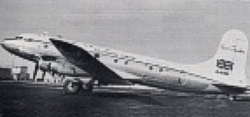
|
|
Avro Tudor transport
|
|
|
|
NOTE: BSAAs North Atlantic Route was flown via Lisbon, Portugal, on to Santa Maria, Azores, across to Bermuda, down to Kingston, Jamaica, West Indies and on to the west coast of South America, down to Santiago, Chile and east, across the Andes, to Buenos Aires, Argentina. Norman was finally able to get back again to the familiar territory of his early childhood adventures.
In 1947, Norman was learning to love the adventure of international airline flying, as I did later, myself. He flew as a Captain with BSAA and later was Station Commander at Santa Maria, in the Azores.
|
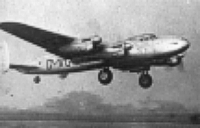
|
|
Lancastrian aircraft
|
|
|
|
It was in August of 1947 that BSAA lost a Lancastrian aircraft. This plane just seemed to vanish. The plane, named “Stardust”, was flying from Buenos Aires, Argentina to Santiago, Chile. This was, at the time, about a four hour flight. Just before Stardust was due to arrive in Santiago, it’s crew sent a Morse Code message confirming their arrival time, but ending with a strange series of letters “S.T.E.N.D.E.C.”. This really baffled the radio operator in Santiago. After that, nothing more was ever heard from Stardust. It was the start of one of the greatest enduring aviation mysteries. It wasn’t until 53 years later that parts of the plane began to appear from the lower portion of the Tupangato Glacier. This was not the crash site. Stardust had hit the mountain near its peak and the glacier had covered it. It became part of the glacier and gradually, over the years, slid down the mountain, until the temperatures at the lower altitudes caused the ice to melt and expel parts of the crashed plane. Norman knew most of the crew, BSAA, being a relatively small airline. He remembered flying some of the search flights over the Andes, with no trace seen of the missing plane. There was a lack of radio beacons and other navigational aides in 1947 and a probable cause of the accident was reached. Analysis of the old weather charts showed that, on the day of the crash, Stardust was flying straight into a jet stream, which was blowing about 100 miles per hour at that time. Even the highest of the Andes mountains were obscured by clouds. The crew had no way of knowing that the high altitude jet stream was slowing them down, destroying all their navigational calculations. Nearing Mendoza, Argentina, just prior to crossing the Andes, Stardust had climbed to 24,000 feet. This was at least 1,500 feet higher than the Andes highest peak, Aconcagua. With no ground reference, they calculated that they had passed over the Andes and started their descent through the clouds for landing at Santiago. Unfortunately, due to the strong head winds, they were still some 50 miles east of their assumed position, and right over the Mount Tupangato glacier. The reason that Norman and the other search pilots never saw any wreckage was probably due to the plane being covered with ice and snow just after the crash.
NOTE: Two more BSAA aircraft were lost, over the Atlantic Ocean, and no trace of them was ever found. A Tudor aircraft disappeared while flying between Santa Maria, Azores and Bermuda in January of 1948. Another Tudor vanished between Bermuda and Kingston, Jamaica in January of 1949. At the time, many speculated that the curse of the Bermuda Triangle had struck again. Norman didn’t think so. He suspected structural failures in the tail of the Tudor planes.
|
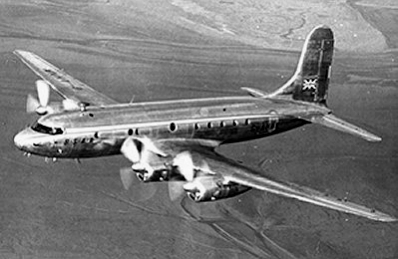
|
|
Avro Tudor transport
|
|
Norman suspected tail failures in crashes
|
|
In 1948, Norman met the love of his life, Edna, through his younger brother in London. Edna says that she was not impressed with Norman on those first dates, but later began to really appreciate his personality and wit. They were married and started to raise a family.
Shortly thereafter, Norman was called upon to fly into Germany once more. In July, 1948, the Russians had shut down all ground travel into and out of the allied zones of Berlin. The city of Berlin was located deep in the center of the Russian Zone of Occupied Germany, and divided into four zones….American, British, French and Russian. The Americans and British had set up a joint zone in West Germany called “Bizonia”, and made plans to issue new currency in West Germany, and West Berlin, as well. This would effectively shut down the black markets and stabilize the West German government. The Russians didn’t want an independent West Germany. They wanted it all under their Communist control. In retaliation, they were trying to drive the allied forces from Berlin by a blockade. They thought that, without supplies, all of West Berlin and its population would fall under their control. The only way in or out of West Berlin then, was by air.
|
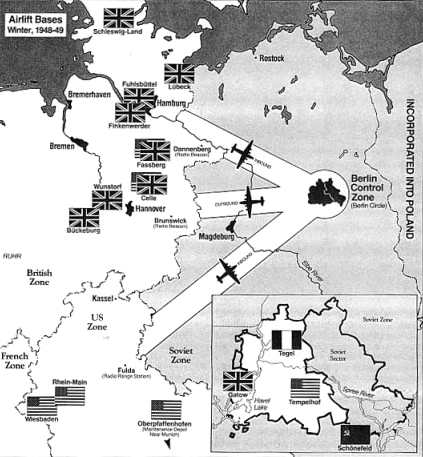
|
|
Map courtesy of TrumanLibrary.com
|
|
|
|
The U. S. Air Force came up with a plan to try to supply the survival needs of the West Berlin by the greatest feat of aviation ever attempted. The answer was the BERLIN AIRLIFT. Thousands of aircraft were assembled from all over the allied world to participate. The USAF primarily provided Douglas C-54 transports. (I flew one of these planes a few years later, and it still had coal dust in the bottom of the fuselage).
The British provided 40 Avro York transports from the RAF, plus some contracted civilian airlines to haul cargo. Norman flew the British South American Airways (BSAA) Avro Tudor aircraft in the airlift. At the peak, during the later part of 1948 and early 1949, there was one landing and takeoff at West Berlin airports every three minutes. The impossible was being done, but at the cost of many lives. Forty-one British pilots alone were lost in the Berlin Airlift. Norman survived the heavy and dangerous flight schedule, but began having trouble with his legs. Norman continued to fly the BERLIN AIRLIFT, but the wounds he had suffered in the BATTLE OF BRITAIN in 1940, began to flair up again. (He had been hit in both legs with incendiary machine gun bullets from the ME-110, and the magnesium had started to attack his bones).
Norman was finally hospitalized in 1949 and had to have one leg amputated below the knee. He had great resolve that this would not slow him down, and indeed, it did not. Norman was fitted with an artificial limb and learned to walk again, without assistance. Losing the leg had ended his airline flying career, but Norman enrolled in a retraining program and learned to become an excellent carpenter and cabinet maker.
In 1950, Norman was continuing to get medical treatments for both leg areas. His remaining one was still giving him some problems. During these years, he increased his skills at woodworking and cabinet making.
In 1954, Norman finally had to have his other leg amputated below the knee. He knew the drill, as he had gone through this before. Now Norman was a double leg amputee, but learned to get around on his two wooden legs, with hardly a limp. He walked the rest of his life without crutches or canes.
In the late 1950s, during his rehabilitation, Norman worked for a tourist company that specialized in tours to Spain. He made hotel and travel arrangements for the company, using his outgoing personality and fluency in the Spanish language.
In the 1960s, Norman expanded his woodworking business to building theater and, later, movie sets. He started out building room sets and became so adept at this that he was called upon quite often to build more elaborate productions. Edna helped get Norman the jobs with the movie company, as she was an accountant with them at the time. Norman enjoyed his independence too much to work for anyone else, so he operated his own business, at his own pace. Over the years, he has also built sets for exhibitions and advertising companies, doing print ads and TV commercials.
In late 1977, the most famous film that Norman designed sets for was “Wild Geese”, which starred Richard Burton, Richard Harris, Roger Moore and Stewart Granger. This was an epic tale of a small group of hand picked SAS type commandos, who were flown into Africa to rescue the imprisoned former president of a third world country.
In October of 1978, Norman and Edna decided to move to Santiago, Chile to open a boutique in the upscale suburb of Las Condes. They imported many products from the Orient, but found out that sales were very seasonal in Chile, and they needed something that would sustain them year round.
In 1980 they opened the Cross Keys Pub in the Las Condes area of Santiago. It was an excellent location, just outside a major subway entrance. Their pub business prospered. The Cross Keys Pub in Santiago became the unofficial “watering hole” of a lot of English speaking people in the city. Many, from the various Embassies and Consulates, would congregate there, along with airline crews and others. There was always an interesting cast of characters gathered at the Cross Keys. Norman had built most of the furnishings for the Pub, himself. There didn’t seem to be anything that Norman couldn’t do, once he set his mind to it. Norman and Edna expanded the pub into two adjoining shops and it prospered until the end of December, 1983, when they lost their lease.
In 1984, they moved to Algorrobo, Chile, near the Pacific coast, and opened another pub. Again, Norman went to work and built most of the pub furnishings. It had only been open for about 6 months, when a severe earthquake in the area, wiped it out. There had been no earthquake insurance available and Norman and Edna lost the pub, but not their spirit. They decided to move back to Santiago to start over.
|
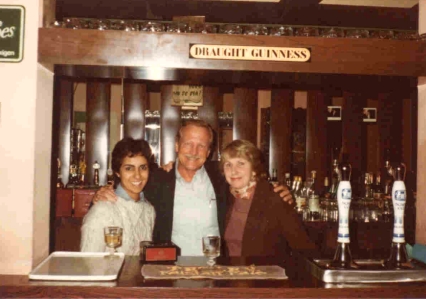
|
|
Original Cross Keys Pub in Santiago, Chile, 1983
|
|
(Barmaid Chris, me and Norman’s wife Edna on R.)
|
|
In 1985, they opened the new Cross Keys Pub, in a spot about a block from their old location in Santiago. Many of their old customers and friends were delighted to, once again, enjoy their hospitality. Their daughter, Helen, had left her flight attendant job with Eastern Air Lines and gone to secretarial school. At the new Cross Keys Pub one evening, the Australian Ambassador (Kevin Flanagan) overheard Norman saying that Helen needed a job and he, promptly, offered her one at his Embassy. She was very proficient in the Spanish language and had worked there for about six months when the British Ambassador heard about it. He asked her why she was working for the “Aussies” when she could be working for him. He called the Australian Ambassador and said that he was stealing her to work for himself at the British Embassy. Helen went to work for the British Ambassador and did so well that they made her Vice Counsel, later, when the vacancy came available.
In 1986, Norman and Edna, after having rebuilt the business, decided to sell the new Cross Keys Pub and retire to Vina del Mar, on the Pacific coast. Vina is a beautiful small city located just north of Valparaiso and about 40 miles west of Santiago. The climate and area is very much like the San Diego to La Jolla, California region, with beautiful beaches and mountains.
In the late 1980s, I was able to visit with Norman and Edna on a number of occasions, while on my airline layovers in Santiago. They had a nicely furnished apartment, with a garden, in Vina. Their apartment was within walking distance of many cafes, pubs and grocers. When travel to further distant spots in the city was required, a local taxi was available. There was excellent bus service from Santiago, that took less than an hour travel time. This was on a scenic route to the sea, and their new retirement home.
Norman had furnished a new pub in Santiago, called the Golden Bell, for his son, Ron. It, too, was located in the same, upscale suburb of Santiago, and was operated by Ron and his wife. Ron had been diagnosed with juvenile diabetes at the age of six and was a bit fragile, and Norman wanted to help him out with a business that he knew best.
In June of 1988, I took early retirement from Eastern Air Lines. A corporate raider had taken over and I didn’t see much future for the airline. I was able to travel on Eastern until it was put in bankruptcy in 1990, so was still able to visit with Norman and Edna. Norman was also able to visit with my wife and me, several times in Miami. Norman was a big hit at our meetings of the “Quiet Birdmen”, a pilot’s social organization that had been formed after WW-1. He knew a few of the old-timers from Panagra and Braniff airlines, that he met at these meetings. Norman boggled their minds with the story of being hired to fly for Panagra at the age of 16. He also attended our Retired Eastern Pilots Association luncheon with me.
In January, 1991, Norman’s daughter, Helen, decided to move to the U.K. after her young daughter had become ill with a respiratory illness. The air in Santiago is very bad most of the time, due to a lot of diesel engine exhaust fumes being trapped in the valley where the city is located. Doctors told Helen that her young daughter may not survive unless they moved to a location with cleaner air. She gave up her job at the British Embassy and, with her husband and daughter, moved to the U.K.
Norman was having some problems with his old wooden legs at this time, so he and Edna decided that it was time for them, also, to move back to the U.K.. There, Norman could get some good medical treatment and “new legs”. After the move to England in February, 1991, Norman’s new doctors said that his old wooden legs belonged in a medical museum. They fitted him with the latest leg prostheses, which allowed Norman much greater comfort while walking.
In May of 1991, tragedy struck the family. Norman and Edna’s youngest son, Michael, who had been living in England, was killed in an auto accident. This was just three months after their return to the U.K.
During the 1990s, Norman kept busy with various projects and business enterprises. He also made some visits to RAF stations and air shows. Norman returned to Santiago for a few visits to see his son, Ron, and also see some of his old friends. Another tragedy happened. Ron died of his ailment in January of 1996, but had lived years beyond the life expectancy of someone with juvenile diabetes.
Norman made a number of trips back to Chile and would visit with his Eastern Air Lines friends in Florida, enroute. On one visit, using his carpentry skills, he helped another retired Eastern Captain, Cliff Umsheid, with building a home at a private airport north of Cocoa, Florida.
In 1998, Norman had entered into a partnership with a small firm engaged in the purchase and sale of light aircraft. Norman was now 82 years young, and when asked, “When was the last time you flew?”, replied, “Oh, it was May of this year. I wanted to try out one of our latest acquisitions”.
In October of 1999, my wife, Lynn, and I flew over to the U.K. to spend a week with Norman and Edna. We rented a car at Heathrow and drove north (on the wrong side of the road) to the small village of Little Wymondley, near Hitchin in Hertfordshire. Norman and Edna had a nice apartment there and their daughter, Helen and her family, lived near by. We had a wonderful time during our week of adventures.
Norman and I drove on day trips to some world-class aircraft museums and airfields, whilst Lynn and Edna went shopping and sightseeing.
|
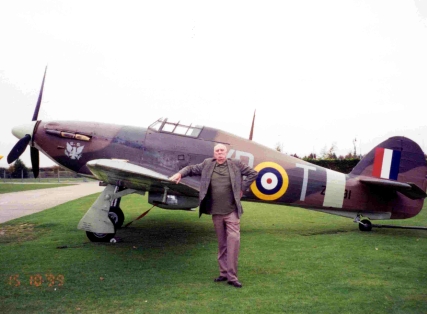
|
|
Norman posing as the “ace of the base”
|
|
with a Huricane at Duxford, 1999
|
|
Norman and I visited the Imperial War Museum at Duxford, England. This was also the location of the American Air Museum in Britain. A few years before, I had become a founding member of that museum, and was able to sponsor a remembrance of Norman’s RAF service in the Battle of Britain. We picked a great day to visit Duxford, as they were practicing for an air show the following day. We got to see Hawker Hurricanes, Spitfires, P-51s, P-47s and others in aerobatic flight. Norman loved hearing the sound of those old “Merlin” engines. Some of the old hangars at Duxford dated back to WW-1, and the runways were still surfaced with grass. We also visited the huge new hangar building, which houses the American Air Museum in Britain collection. Another day, Norman directed me to the Old Warden Aerodrome, where the noted Shuttleworth Collection of famous and antique aircraft is on display.
|
|
|
Norman relaxing with Nattie (grandaughter), Edna and David
|
|
Taken 2003 by David’s wife who is from Eduador
|
|
After a day of driving, Norman and I would lift a pint or two in one of the area pubs, and talk about our bygone days in Chile. Then it was back to pick up our wives and have dinner at a local pub near their home. We had a great visit and stored away wonderful memories.
In June 2002, Norman took Edna to Spain to show her some of the places he had been during the bad days of 1936. He pointed out some of the bullet holes that still remained in some walls of Madrid, where he had been fighting in the Spanish Civil War.
|
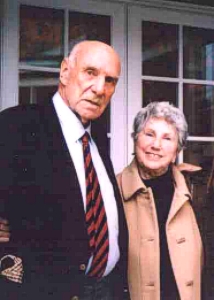
|
|
Last photograph of Norman
|
|
Taken with Edna on Christmas Day, 2003
|
|
We would communicate by Christmas cards and phone calls every year. The last time I spoke with Norman was in December of 2003. Edna had told me that he was very ill with cancer, but still getting around on his own. His memory and wit were sharp until the end, and I’ll never cease to remember this fine gentleman….the most unforgettable character I’ve ever met.
Captain Jim Blackburn, 2004
|
|
|
|
|
|
|

|
Previous Page
|
The End
|
Next Page
|

|
|
|
|
|
|
|
|
But His Memory Lives On
|